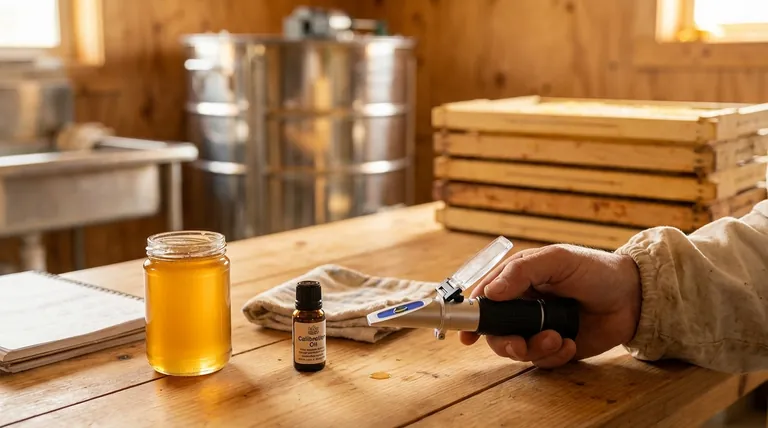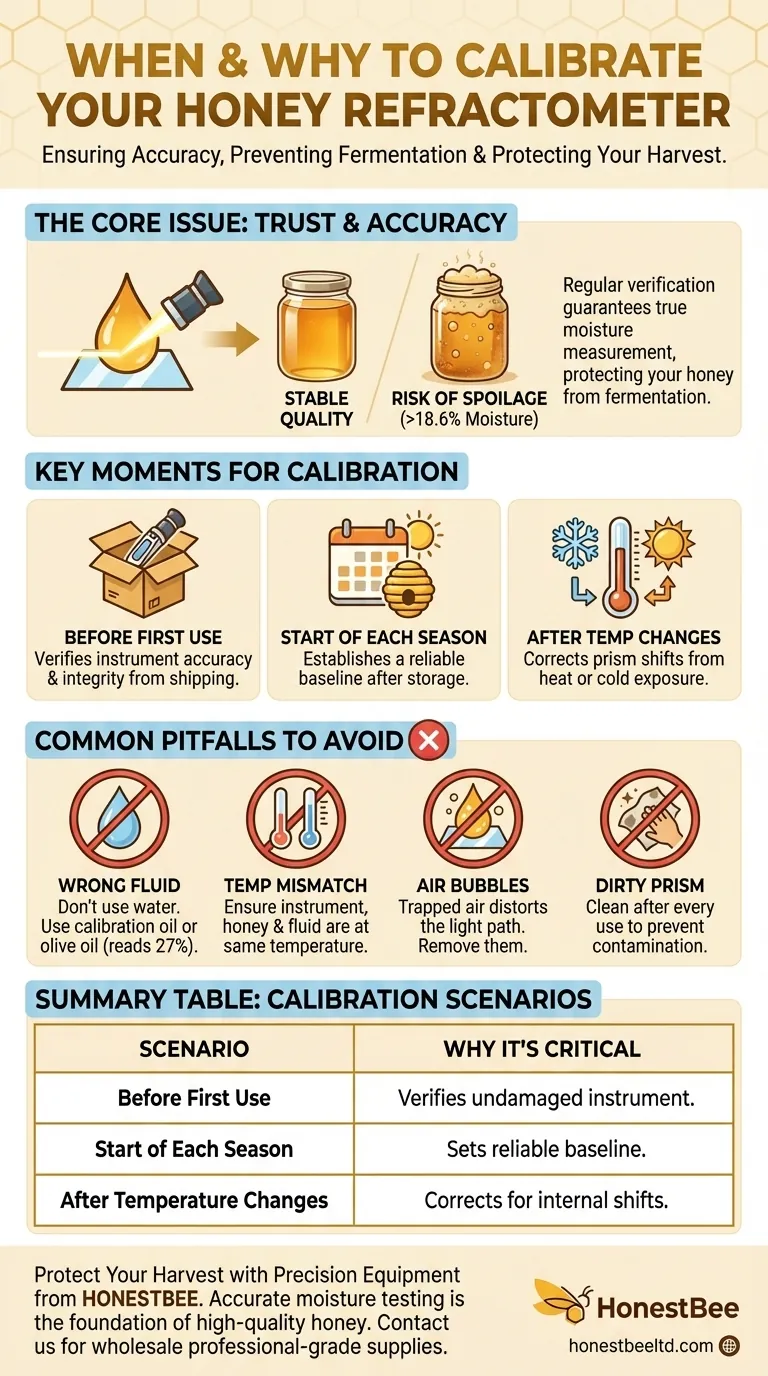As a rule, a honey refractometer should be calibrated before its first use, at the start of each new honey season, and any time it is exposed to extreme temperature changes. This regular verification is essential for ensuring the accuracy of your moisture content readings, which directly impacts the quality and stability of your honey.
The core issue isn't about following a rigid schedule, but about trust. Calibrating your refractometer is the fundamental step that guarantees your instrument is providing a true measurement, protecting your harvest from the risk of fermentation and spoilage.

Why Calibration is Non-Negotiable
A refractometer is a precision instrument, and its accuracy can be compromised by environmental factors, storage, and handling. Proper calibration ensures that your measurements are reliable and your honey meets quality standards.
The Critical Role of Moisture Content
The percentage of water in honey is the single most important factor in determining its shelf life. Honey with a moisture content above 18.6% is at a high risk of fermenting. An inaccurate refractometer could lead you to bottle honey that is unstable, potentially ruining an entire batch.
How a Refractometer Works
This device operates by measuring the refractive index of a substance—how much a beam of light bends when it passes through the honey. This measurement correlates directly to the water content. Even minor shifts in the instrument's internal prisms can throw off this reading significantly.
The Cost of Inaccuracy
A reading that is off by just one or two percent can be the difference between stable, high-quality honey and a fermented, unsellable product. Calibration removes this uncertainty and validates your process.
The Key Moments for Calibration
Certain events and milestones are clear indicators that it's time to check your refractometer's accuracy. Think of these as mandatory checkpoints for quality control.
Before First Use
Always calibrate a new refractometer right out of the box. This establishes a correct baseline and confirms the instrument was not damaged or misaligned during shipping.
At the Start of Each Season
After a long period of storage, it's crucial to recalibrate. This ensures your first measurement of the new harvest is accurate and sets a reliable standard for the entire season.
Following Temperature Fluctuations
Temperature is the most common cause of inaccurate readings. If you move the refractometer between a cool storage area and a warm processing room, or if it's left in a hot vehicle, you must let it acclimate to the ambient temperature and then recalibrate.
Common Pitfalls That Invalidate Readings
Beyond the timing of calibration, several procedural errors can lead to incorrect measurements. Avoiding these is just as important as the calibration itself.
Using the Wrong Calibration Fluid
Most refractometers come with a specific reference solution or calibration oil. If you lose it, pure olive oil is a widely accepted substitute, as it should read 27% on the honey moisture scale. Do not use water, as it is outside the instrument's readable range.
Temperature Mismatch
For a valid reading, the refractometer, the honey sample, and the calibration fluid must all be at the same ambient temperature. Testing cold honey with a warm refractometer will produce a false reading.
Improper Sample Application
Apply just a few drops of honey—enough to cover the glass prism completely. Trapped air bubbles will interfere with the light path and distort the reading. Gently wiggling the cover plate can help remove them.
Neglecting to Clean the Instrument
After every single use, clean the prism and cover plate with a soft, damp cloth. Dried honey residue from a previous test will contaminate your next sample and guarantee an inaccurate result.
Making the Right Choice for Your Goal
Your calibration frequency and rigor should match your operational goals. Use these guidelines to create a strategy that fits your needs.
- If your primary focus is hobbyist beekeeping: Calibrating thoroughly at the start of each season is your most critical checkpoint for ensuring a quality harvest.
- If your primary focus is commercial production: Calibrate daily before starting work, and re-check any time your working environment changes temperature significantly.
- If your instrument has been dropped or handled roughly: Recalibrate immediately to verify its integrity before trusting it with another measurement.
Consistent calibration transforms your refractometer from a simple tool into a reliable guardian of your honey's quality.
Summary Table:
| Calibration Scenario | Why It's Critical |
|---|---|
| Before First Use | Verifies the instrument is accurate and undamaged from shipping. |
| Start of Each Season | Establishes a reliable baseline for the new harvest after storage. |
| After Temperature Changes | Corrects for shifts in the instrument's internal prisms caused by heat or cold. |
Protect Your Harvest with Precision Equipment from HONESTBEE
Accurate moisture testing is the foundation of high-quality, stable honey. For commercial apiaries and beekeeping equipment distributors, reliable tools are non-negotiable. HONESTBEE supplies durable, professional-grade beekeeping supplies and equipment through wholesale-focused operations, ensuring your business has the tools it needs to succeed.
Let's discuss your equipment needs. Contact our team today to learn more about our wholesale offerings and how we can support your operation.
Visual Guide

Related Products
- Honey Concentrating Vacuum Heating Thickening Machine Dehumidifier for Honey
- Professional Thermostatic Conical Honey Melter
- Plastic Hand Crank 2 Frame Honey Extractor Low Price
- 10L Stainless Steel Electric Honey Press Machine
- Electric Honey Press Machine for Squeezing Honey Comb Press Equipment
People Also Ask
- How is the cooling system configured when using tap water in the honey vacuum thickener? A Simple Guide for Beekeepers
- What are the benefits of a honey concentrator? Elevate Your Honey Quality and Market Value
- What are the benefits of motorized honey extractors? Save Time & Labor in Your Apiary
- What additional functions does a honey vacuum thickener have? Achieve a Stable, Commercial-Grade Product
- What is required for the cooling system when using circulating water in the honey vacuum thickener? Essential Components for Efficient Processing



















